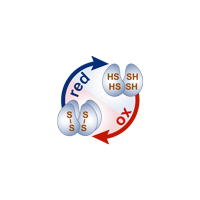Kathrin Ulrich
Curriculum vitae:
- Oct 2022 - today Juniorprofessor for Cellular Biochemistry at the Institute of Biochemistry, University of Cologne
- Oct 2022 NRW-Rückkehrprogramm: Programm zur Förderung der Rückkehr des hochqualifizierten Forschungsnachwuchses aus dem Ausland
- Jul 2017 - Sept 2022 Postdoc at the University of Michigan, USA with Ursula Jakob in collaboration with Blanche Schappach at the University of Goettingen
- Oct 2012 - Apr 2017 PhD at the University of Heidelberg with R. Luise Krauth-Siegel
- Oct 2010 - Oct 2011 Research internship at Kyoto University, Japan with Masao Matsuoka
- Oct 2009 - Aug 2012 M.Sc. Molecular Bioscience at the University of Heidelberg
- Oct 2006 - Jul 2009 B.Sc. Molecular Cell Biology at the University of Heidelberg
Selected publications:
-
Ulrich K. (2023) Redox-regulated chaperones in cell stress responses. Biochem Soc Trans, BST20221304
-
Ulrich K, Farkas A, Chan O, Katamanin O, Schwappach B, Jakob U (2022) From guide to guard – Activation mechanism of the stress-sensing chaperone Get3. Mol Cell 82(17):3226-3238.e7
-
Becker SH, Ulrich K, Dhabaria A, Ueberheide B, Beavers W, Skaar E, Iyer L, Aravind L, Jakob U, Darwin KH (2020) Mycobacterium tuberculosis Rv0991c is a novel redox-regulated molecular chaperone. mBio 11(4):e01545-20
-
Bazopoulou D, Knoefler D, Zheng Y, Ulrich K, Oleson B, Xie L, Kim M, Kaufmann A, Lee Y, Dou Y, Chen Y, Quan S, Jakob U (2019) Developmental ROS individualizes organismal stress resistance and lifespan. Nature 576 (7786): 301-305
-
Currier R B*, Ulrich K*, Leroux A E*, Dirdjaja N, Deambrosi M, Bonilla M, Ahmed Y L, Adrian L, Antelmann H, Jakob U, Comini M A, Krauth-Siegel R L (2019) An essential thioredoxin-type protein of Trypanosoma brucei acts as redox-regulated mitochondrial chaperone. PLoS Pathog 15(9):e1008065
-
Ulrich K, Finkenzeller C, Merker S, Rojas F, Matthews K, Ruppert T, Krauth-Siegel R L (2017) Stress-induced protein S-glutathionylation and S-trypanothionylation in African trypanosomes – a quantitative redox proteome and thiol analysis. Antioxid Redox Signal 27(9): 517-533
